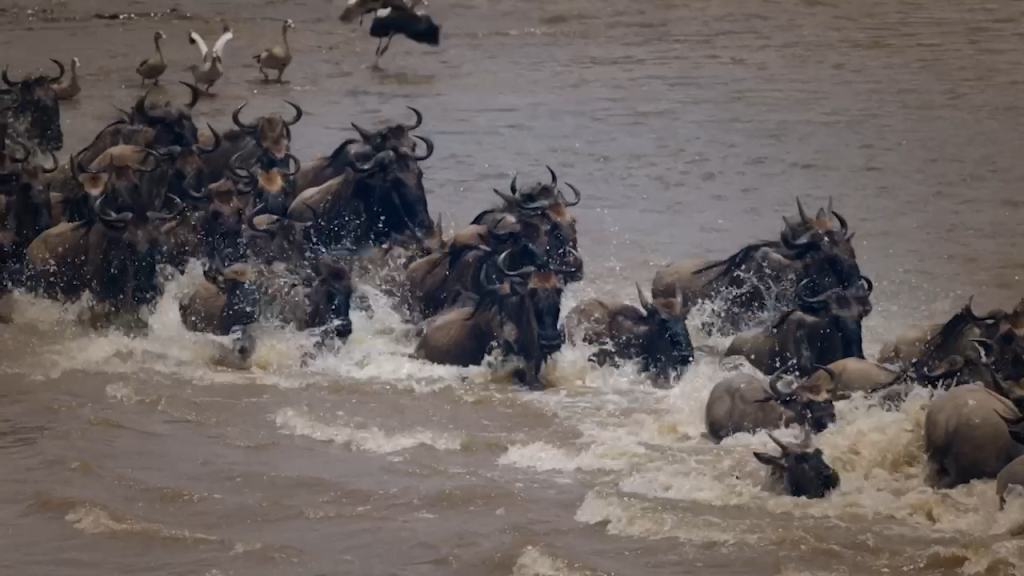The Great Wildebeest Migration refers to the greatest movement of wildlife in the world, this spectacle happen in the Mara- Serengeti ecosystem – a region of about 1000 square Kilometers in Tanzania’s Serengeti National Park and cross over into Masai Mara National Reserve in Kenya and later return to do it all over again every year.
What makes a million wildebeest get up and move at once? What is the sense that triggers them to muster the energy to begin a 1000 kilometer trek – to somehow know that it is the right thing to do?. These questions are a reason why millions of travelers flock Serengeti National Park and Masai Mara National Reserve to find answers and witness Africa’s greatest wildlife show and the largest mass movement of mammals anywhere on the planet.
This article gives you a sneak peak into what you would experience on a wildebeest migration safari
The Greatest African Savannah Show
The number of wildebeests, zebras and elands that participate in the Great Migration vary annual, but it is estimated that the size of the herds can reach 1.5 million wildebeest, a million of zebras, topi and elands.
During the migration, waves of zebras arrive first, mowing through the tall coarse grass stems that shot up during the rains and exposing the green leafy grasses preferred by the wildebeests following behind them.
While the great migration route changes every year, the herds will inevitable have to cross the Mara, Grumeti and Talek rivers. When the reach the river banks, the herds stall hesitantly, knowing full well that the Nile crocodiles like in the waters awaiting. While there is safety in numbers, the herd will be thinned as thousands are eaten, crushed or drowned into the crossings. Those that do make it to the other side are not in the clear. Lions wait in ambush, with scavengers such as hyenas and jackals eyeing good pickings. Also there are cheetahs hiding out in the short grass plains and leopards silently waiting in the treetops.
During the great migration, predator kills are common especially in the early morning, late afternoon and during the shelter of night. But no matter how many Natgeo vides you may have already seen, nothing can prepare you for this raw display of nature. The hairs on the back of your neck will stand for attention and an emotional mix of awe and sympathy takes hold. Most of the times the prey is caught unaware and other times, the struggle to survive is fierce and even inspiring. But when death does take hold in the wild, it is anything but a pretty sight.

The Unfolding of The Great Wildebeest Migration
By early June a gentle wind ripples through the tall golden savannah grass, and the only animals easily visible are the slow moving elephants herds, giraffes or a lone antelope chewing away its meal in quietness. A stillness sits across the savannah and the lions of the plains lie in the shade of the acacias waiting in anticipation.
On the late morning, small specks of dust rise up through the bushes by the Sand River and within minutes become clouds of dust. A herd of a few hundred wildebeest swarms its way along and then down the dusty river bank. Some of the herd settles for a few sips of water before the throng returns and takes the thirsty back to the top of the river bank. The migration has arrived.
Within a couple of days many herds of thousands of wildebeests are trampling their way through the long grass, snaking their way across to look-out Hill and then down to the Mara River.
Most of the visitors only want to see the migration river crossings but the true spectacle of the migration is 1,500,000 wildebeests, a million Burchell’s zebras, eland and Thomson’s gazelle filling the entire stretch of landscape. The shifting columns of the herds as they traverse the valleys and the hills can only be watched in awe, there is no wildlife spectacle like this on earth.
The Annual Migration Cycle
December to March – New Members of the herd
By December, the lure of the rains and a taste of fresh, sweet grass leads the wildebeest to gather on the southern plains of Tanzania’s Serengeti National Park. It is in this period that the iconic photographs that you see on the cover of National Geographic of the vast, emerald green plains dotted with throngs of animals are happening.
The majority of female plumb wildebeests are preparing to give birth and after a feast of nutritious grass in January, birthing season begins in earnest in February and March. The fertile female usually drop their young within a few weeks of each other and the plains heave with almost half a million new, fluffy lives. It is an incredible spectacle to witness, but prepare for some violent scenes too for the predators are never far away and its almost as if they know they will have easy pickings from the young.
The weather?
It is typically a rainy time in Tanzania from December to March, and the showers are at their heaviest in December and at the beginning of January. By mid-January, the rains lessen and Tanzania enters a mini dry season so you will have dreams of a blue-sky-filled Great Wildebeest Migration Safari. Don’t shun this time of the year and the magic of the birthing season just yet (still so bring a rain jacket, just in case).
April to Mid-June – Mating Season & Trek North
As the rains come to an end in the southern Serengeti and the grasses start to dry and shrivel, the beasties start their trek to the next destination – the north in search of fresh grass. Throughout the middle section of the Serengeti and into the west as they begin the mammoth trek. April and the beginning of May see the herds congregating in the central areas of the Serengeti around the Moru Kopjes amd if you are lucky, you will spot the battling males as they fight fiercely for a mate. By the end of May most of the herds will have reached the Western Corridor of the Serengeti and the Grumeti Reserve. It is here that they gather on the banks of the Grumeti River to face the first real challenge of the trek, crossing the water.
The Weather?
The long rains period starts in Tanzania around April and they continue into May so this is a wet time of the year. Some of the mobile camps may close as the ground isn’t solid enough, so you have to choose your accommodation in advance. Also pack a raincoat, waterproof bag for your camera and go, go go.

Mid June to November
Often it is said that the start of the Great Wildebeest Migration show is the river crossings during which the herds take the leap from Serengeti into Masai Mara across the might Mara River. These are months of drama and exhilaration, chaos and commotion and watching the wildebeest plunge across the water is undoubtedly some of the most exciting game viewing you will ever witness.
Around 250,000 wildebeests die every year during the migration, the majority of them here, as predators roam the banks and crocodiles like in wait. In June, most of the herds are plodding towards the river and beginning to gather on the northern plains of the Serengeti. The action really gets going in July when the first crossings take place and the watery stampede continues into August and September when the wildebeest regroup for a short breather on the Masai Mara side of the river.
The Weather?
June to November is considered the dry season in these parts of Africa and picture-perfect, cloudless skies and plenty of sunshine are great for the game. June to July are the coldest months in Eastern Africa and the mornings and evenings in particular can be a touch chilly so you will need a scarf and gloves won’t go a miss in the down chill. From August, the temperatures get steadily hotter until November when the spell is broken by the first of the rains.
Great weather and iconic game viewing and a pretty good time to visit.
October – November – The return Journey
The drama isn’t over yet for the poor wildebeests and their migration party, however, for they must return to Tanzania. So in October, the action starts up again as the wildebeest face the second crossing of the Mara River and back to the northern plains of the Serengeti.
As November rolls around, so do the thunderclouds in the distance and with a sniff of the air and stamp of the ground, the wildebeest are off to find the fresh, green shoots of the south. Thundering through the eastern section of the Serengeti and flooding the central area once again, the herds arrive safely back in the southern Serengeti in December and the cycle is complete.
Inquire with us to start planning your Great Wildebeest Migration Safari


